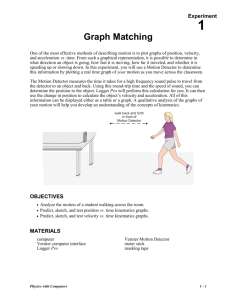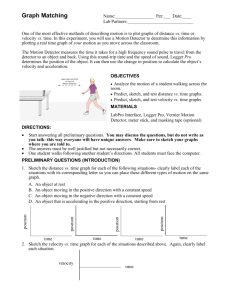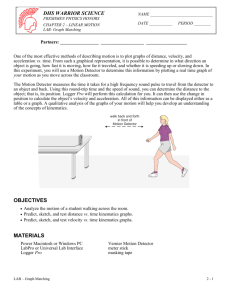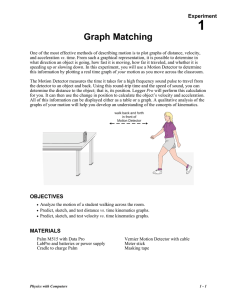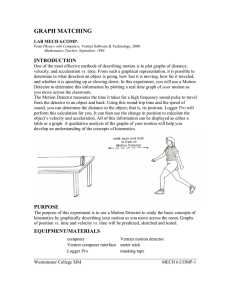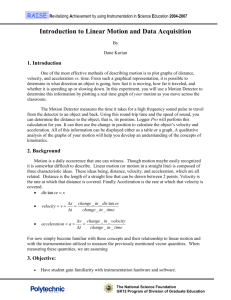Linear Motion Lab 1
advertisement
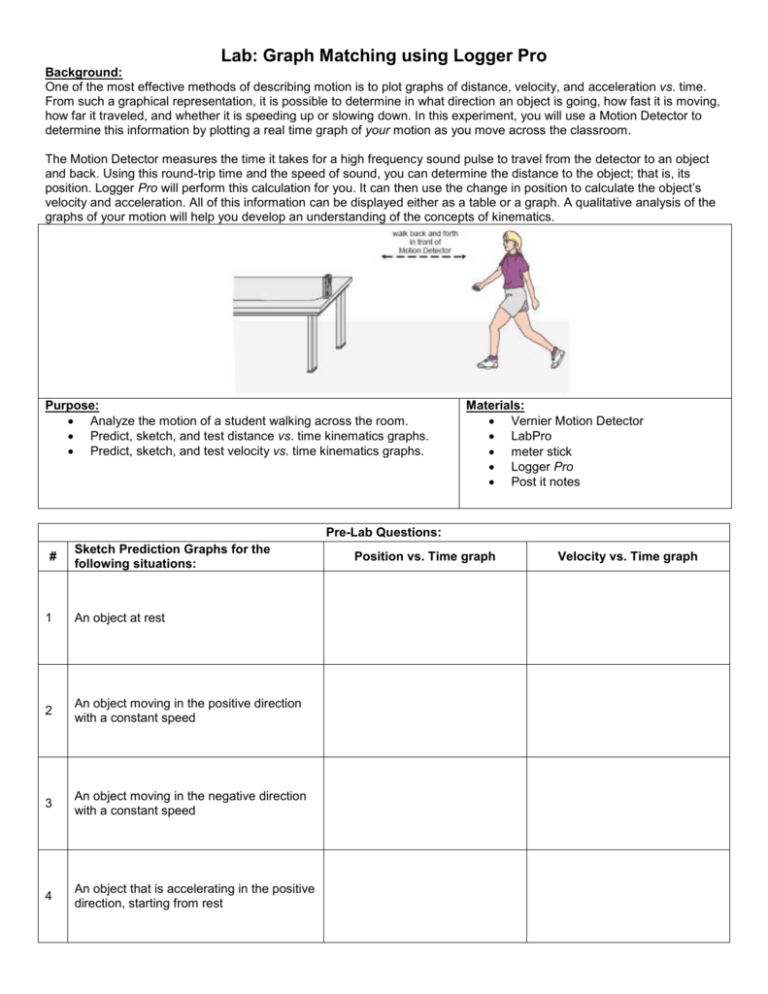
Lab: Graph Matching using Logger Pro Background: One of the most effective methods of describing motion is to plot graphs of distance, velocity, and acceleration vs. time. From such a graphical representation, it is possible to determine in what direction an object is going, how fast it is moving, how far it traveled, and whether it is speeding up or slowing down. In this experiment, you will use a Motion Detector to determine this information by plotting a real time graph of your motion as you move across the classroom. The Motion Detector measures the time it takes for a high frequency sound pulse to travel from the detector to an object and back. Using this round-trip time and the speed of sound, you can determine the distance to the object; that is, its position. Logger Pro will perform this calculation for you. It can then use the change in position to calculate the object’s velocity and acceleration. All of this information can be displayed either as a table or a graph. A qualitative analysis of the graphs of your motion will help you develop an understanding of the concepts of kinematics. Purpose: Analyze the motion of a student walking across the room. Predict, sketch, and test distance vs. time kinematics graphs. Predict, sketch, and test velocity vs. time kinematics graphs. Materials: Vernier Motion Detector LabPro meter stick Logger Pro Post it notes Pre-Lab Questions: # Sketch Prediction Graphs for the following situations: 1 An object at rest 2 An object moving in the positive direction with a constant speed 3 An object moving in the negative direction with a constant speed 4 An object that is accelerating in the positive direction, starting from rest Position vs. Time graph Velocity vs. Time graph PROCEDURE Part 1 Preliminary Experiments 1. Connect the Motion Detector to the DIG/SONIC 1 channel of the interface. If the Motion Detector has a sensitivity switch, set it to Normal (or the person). 2. Place the Motion Detector so that it points toward an open space at least 4 m long. It may be helpful to use post it notes on the floor to mark the 1 m, 2 m, 3 m, and 4 m positions from the Motion Detector. 3. Open the file “01a Graph Matching” from the Physics with Vernier folder. 4. Using Logger Pro, produce a graph of your motion when you walk away from the detector with constant velocity. To do this, stand about 1 m from the Motion Detector and have your lab partner click . Walk slowly away from the Motion Detector when you hear it begin to click. Sketch what it looks like in the left box below (#4). 5. Sketch a prediction what the position vs. time graph will look like if you walk faster. Check your prediction with the Motion Detector. Sketch what it looks like in the right box below. #4 #5 6. Check your answers for the prelab shape of the position vs. time graphs that you sketched in the Preliminary Questions section by walking in front of the Motion Detector. Part 2 Position vs. Time Graph Matching 7. Open the experiment file “01b Graph Matching.” A position vs. time graph will appear. 8. Describe how you would walk to produce this target graph. See Data table on next page. 9. To test your prediction, choose a starting position and stand at that point. Start data collection by clicking . When you hear the Motion Detector begin to click, walk in such a way that the graph of your motion matches the target graph on the computer screen. 10. If you were not successful, repeat the process until your motion closely matches the graph on the screen. Save a copy of the graph with your best attempt. You will copy/paste this into Word and share with your instructor. 11. Open the experiment file “01c Graph Matching” and repeat Steps 8–10, using a new target graph. 01b 1 Describe how you walked for each of the graphs that you matched. 01c 2 Explain the meaning of the slope of a position vs. time graph. Include a discussion of positive and negative slope. 3 What type of motion is occurring when the slope of a position vs. time graph is zero? 4 What type of motion is occurring when the slope of a position vs. time graph is constant? 5 What type of motion is occurring when the slope of a position vs. time graph is changing? Test your answer to this question using the Motion Detector. Part 3 Velocity vs. Time Graph Matching 12. 13. 14. 15. 16. 17. Open the experiment file “01d Graph Matching.” A velocity vs. time graph will appear. Describe how you would walk to produce this target graph. To test your prediction, choose a starting position and stand at that point. Start by clicking . When you hear the Motion Detector begin to click, walk in such a way that the graph of your motion matches the target graph on the screen. It will be more difficult to match the velocity graph than it was for the position graph. Save and copy/paste your best trial into the same Word document as your previous graphs. Open the experiment file “01e Graph Matching.” Repeat Steps 14–15 to match this graph. Remove the post it notes from the floor. Share your Word document containing your three graph matches with your instructor via email or Google Drive. 01d 1 Describe how you walked for each of the graphs that you matched. 01e 2 What type of motion is occurring when the slope of a velocity vs. time graph is zero? 3 What type of motion is occurring when the slope of a velocity vs. time graph is not zero? Test your answer using the Motion Detector

